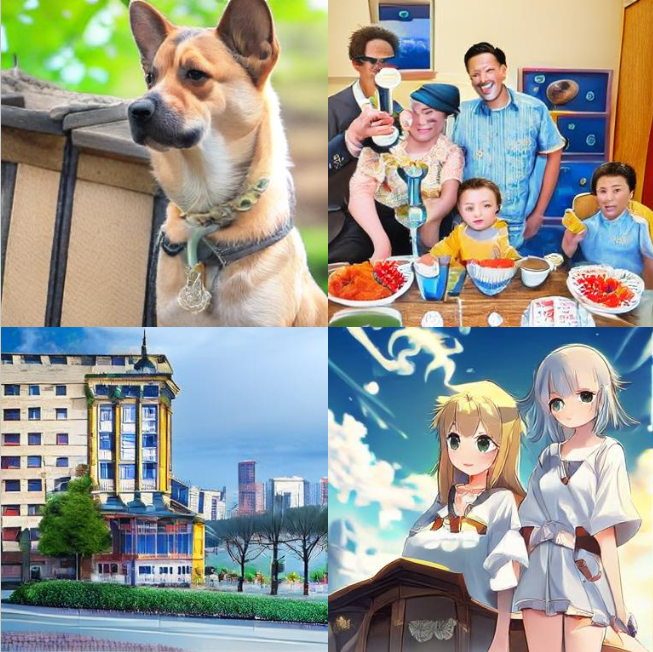
Janus ist ein neues autoregressives Framework, das multimodales Verständnis und Generierung integriert. Im Gegensatz zu früheren Modellen, die einen einzigen visuellen Encoder sowohl für Verständnis- als auch für Generierungsaufgaben verwendeten, führt Janus zwei separate visuelle Codierungspfade für diese Funktionen ein.
Hier sind die Schritte zum Ausführen von Janus in Google Colab:
git clone https://github.com/deepseek-ai/Janus cd Janus pip install -e . # If needed, install the following as well # pip install wheel # pip install flash-attn --no-build-isolation
Verwenden Sie den folgenden Code, um das erforderliche Modell für Vision-Aufgaben zu laden:
import torch from transformers import AutoModelForCausalLM from janus.models import MultiModalityCausalLM, VLChatProcessor from janus.utils.io import load_pil_images # Specify the model path model_path = "deepseek-ai/Janus-1.3B" vl_chat_processor = VLChatProcessor.from_pretrained(model_path) tokenizer = vl_chat_processor.tokenizer vl_gpt = AutoModelForCausalLM.from_pretrained(model_path, trust_remote_code=True) vl_gpt = vl_gpt.to(torch.bfloat16).cuda().eval()
Als nächstes laden Sie das Bild und konvertieren es in ein Format, das das Modell verstehen kann:
conversation = [
{
"role": "User",
"content": "<image_placeholder>\nDescribe this chart.",
"images": ["images/pie_chart.png"],
},
{"role": "Assistant", "content": ""},
]
# Load the image and prepare input
pil_images = load_pil_images(conversation)
prepare_inputs = vl_chat_processor(
conversations=conversation, images=pil_images, force_batchify=True
).to(vl_gpt.device)
# Run the image encoder and obtain image embeddings
inputs_embeds = vl_gpt.prepare_inputs_embeds(**prepare_inputs)
Führen Sie abschließend das Modell aus, um eine Antwort zu generieren:
# Run the model and generate a response
outputs = vl_gpt.language_model.generate(
inputs_embeds=inputs_embeds,
attention_mask=prepare_inputs.attention_mask,
pad_token_id=tokenizer.eos_token_id,
bos_token_id=tokenizer.bos_token_id,
eos_token_id=tokenizer.eos_token_id,
max_new_tokens=512,
do_sample=False,
use_cache=True,
)
answer = tokenizer.decode(outputs[0].cpu().tolist(), skip_special_tokens=True)
print(f"{prepare_inputs['sft_format'][0]}", answer)

The image depicts a pie chart that illustrates the distribution of four different categories among four distinct groups. The chart is divided into four segments, each representing a category with a specific percentage. The categories and their corresponding percentages are as follows: 1. **Hogs**: This segment is colored in orange and represents 30.0% of the total. 2. **Frog**: This segment is colored in blue and represents 15.0% of the total. 3. **Logs**: This segment is colored in red and represents 10.0% of the total. 4. **Dogs**: This segment is colored in green and represents 45.0% of the total. The pie chart is visually divided into four segments, each with a different color and corresponding percentage. The segments are arranged in a clockwise manner starting from the top-left, moving clockwise. The percentages are clearly labeled next to each segment. The chart is a simple visual representation of data, where the size of each segment corresponds to the percentage of the total category it represents. This type of chart is commonly used to compare the proportions of different categories in a dataset. To summarize, the pie chart shows the following: - Hogs: 30.0% - Frog: 15.0% - Logs: 10.0% - Dogs: 45.0% This chart can be used to understand the relative proportions of each category in the given dataset.
Die Ausgabe zeigt ein angemessenes Verständnis des Bildes, einschließlich seiner Farben und seines Textes.
Laden Sie das erforderliche Modell für Bildgenerierungsaufgaben mit dem folgenden Code:
import os import PIL.Image import torch import numpy as np from transformers import AutoModelForCausalLM from janus.models import MultiModalityCausalLM, VLChatProcessor # Specify the model path model_path = "deepseek-ai/Janus-1.3B" vl_chat_processor = VLChatProcessor.from_pretrained(model_path) tokenizer = vl_chat_processor.tokenizer vl_gpt = AutoModelForCausalLM.from_pretrained(model_path, trust_remote_code=True) vl_gpt = vl_gpt.to(torch.bfloat16).cuda().eval()
Als nächstes bereiten Sie die Eingabeaufforderung basierend auf der Anfrage des Benutzers vor:
# Set up the prompt
conversation = [
{
"role": "User",
"content": "cute japanese girl, wearing a bikini, in a beach",
},
{"role": "Assistant", "content": ""},
]
# Convert the prompt into the appropriate format
sft_format = vl_chat_processor.apply_sft_template_for_multi_turn_prompts(
conversations=conversation,
sft_format=vl_chat_processor.sft_format,
system_prompt="",
)
prompt = sft_format + vl_chat_processor.image_start_tag
Die folgende Funktion wird zum Generieren von Bildern verwendet. Standardmäßig werden 16 Bilder generiert:
@torch.inference_mode()
def generate(
mmgpt: MultiModalityCausalLM,
vl_chat_processor: VLChatProcessor,
prompt: str,
temperature: float = 1,
parallel_size: int = 16,
cfg_weight: float = 5,
image_token_num_per_image: int = 576,
img_size: int = 384,
patch_size: int = 16,
):
input_ids = vl_chat_processor.tokenizer.encode(prompt)
input_ids = torch.LongTensor(input_ids)
tokens = torch.zeros((parallel_size*2, len(input_ids)), dtype=torch.int).cuda()
for i in range(parallel_size*2):
tokens[i, :] = input_ids
if i % 2 != 0:
tokens[i, 1:-1] = vl_chat_processor.pad_id
inputs_embeds = mmgpt.language_model.get_input_embeddings()(tokens)
generated_tokens = torch.zeros((parallel_size, image_token_num_per_image), dtype=torch.int).cuda()
for i in range(image_token_num_per_image):
outputs = mmgpt.language_model.model(
inputs_embeds=inputs_embeds,
use_cache=True,
past_key_values=outputs.past_key_values if i != 0 else None,
)
hidden_states = outputs.last_hidden_state
logits = mmgpt.gen_head(hidden_states[:, -1, :])
logit_cond = logits[0::2, :]
logit_uncond = logits[1::2, :]
logits = logit_uncond + cfg_weight * (logit_cond - logit_uncond)
probs = torch.softmax(logits / temperature, dim=-1)
next_token = torch.multinomial(probs, num_samples=1)
generated_tokens[:, i] = next_token.squeeze(dim=-1)
next_token = torch.cat([next_token.unsqueeze(dim=1), next_token.unsqueeze(dim=1)], dim=1).view(-1)
img_embeds = mmgpt.prepare_gen_img_embeds(next_token)
inputs_embeds = img_embeds.unsqueeze(dim=1)
dec = mmgpt.gen_vision_model.decode_code(
generated_tokens.to(dtype=torch.int),
shape=[parallel_size, 8, img_size // patch_size, img_size // patch_size],
)
dec = dec.to(torch.float32).cpu().numpy().transpose(0, 2, 3, 1)
dec = np.clip((dec + 1) / 2 * 255, 0, 255)
visual_img = np.zeros((parallel_size, img_size, img_size, 3), dtype=np.uint8)
visual_img[:, :, :] = dec
os.makedirs('generated_samples', exist_ok=True)
for i in range(parallel_size):
save_path = os.path.join('generated_samples', f"img_{i}.jpg")
PIL.Image.fromarray(visual_img[i]).save(save_path)
# Run the image generation
generate(vl_gpt, vl_chat_processor, prompt)
Die generierten Bilder werden im Ordner „generated_samples“ gespeichert.
Unten finden Sie ein Beispiel für ein generiertes Bild:

Das obige ist der detaillierte Inhalt vonJanus B: Ein einheitliches Modell für multimodale Verständnis- und Generierungsaufgaben. Für weitere Informationen folgen Sie bitte anderen verwandten Artikeln auf der PHP chinesischen Website!
 Verwendung von UpdatePanel
Verwendung von UpdatePanel
 Wie richte ich WeChat so ein, dass meine Zustimmung erforderlich ist, wenn mich jemand zu einer Gruppe hinzufügt?
Wie richte ich WeChat so ein, dass meine Zustimmung erforderlich ist, wenn mich jemand zu einer Gruppe hinzufügt?
 So verwenden Sie Spyder
So verwenden Sie Spyder
 Was ist der Unterschied zwischen CSS-Framework und Komponentenbibliothek?
Was ist der Unterschied zwischen CSS-Framework und Komponentenbibliothek?
 Konfigurieren Sie die HOSTS-Datei
Konfigurieren Sie die HOSTS-Datei
 Welche Methoden der Fernwartung von Computern gibt es?
Welche Methoden der Fernwartung von Computern gibt es?
 Was sind die gängigen Testtechniken?
Was sind die gängigen Testtechniken?
 Verwendung von Kordelzug
Verwendung von Kordelzug
 Wie ist die Leistung von thinkphp?
Wie ist die Leistung von thinkphp?




